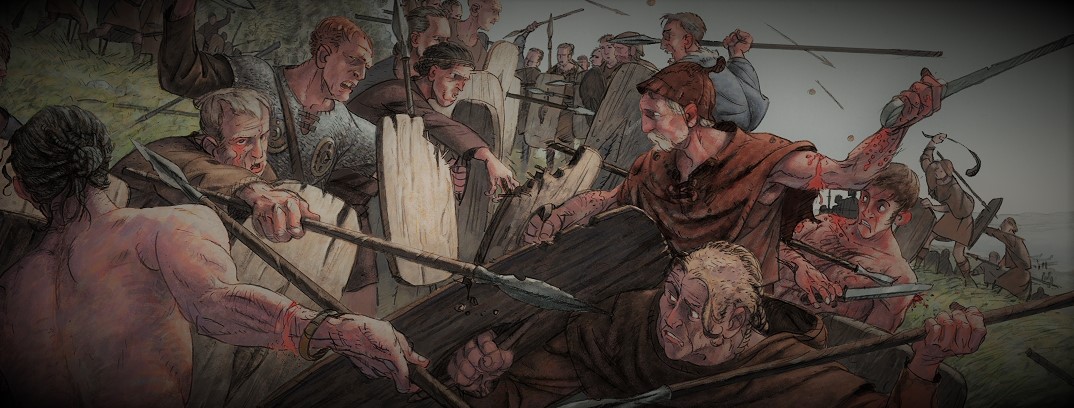2500 to 800 BC
The great sweeping forests of England were gradually cleared and new open spaces encompassed thriving communities with areas for growing crops such as straw, wheat and barley. Cattle, sheep and goats meandered amongst them and grazed on grassland nearby.
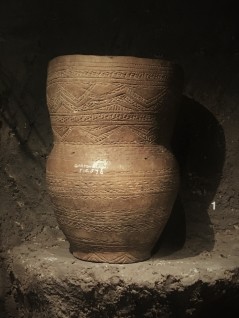
Settlers came from mainland Europe bringing new skills and ideas. They became known as the ‘Bell Beaker’ folk because of the distinctive bell shaped cups discovered at burial sites all over Britain and Europe.
These new skills included decorative working with gold and the smelting of copper and tin to make an alloy of bronze that was used to make weapons like swords and arrow heads, buckles, jewellery and tools. With the influx of people over the years, arable land became more desirable and the need for weapons increased so as to defend from or invade other settlements.
Bronze Age East Yorkshire
Hull and around was essentially a region of alluvium and salt marshes, host to a myriad of creatures, birds and fish in the Humber. Holderness wetlands was inhabited, and there’s evidence of barrow graves at many sites across East Yorkshire. It is likely that the area had a fairly good population by this time, with evidence of woodland clearing, crops and tools discovered.
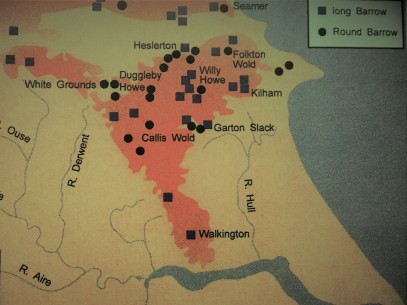
Goodmanham; Lund; Market Weighton; Wold Newton; Fimber; Warter; Carnaby; Huggate; Thwing; Millington; Cottingham; Burton Agnes; Harpham; Beverley Westwood; Bridlington; Walkington; Newbald; Bishop Burton; Wawne; Cherry Burton; Bempton; Rudston; All have bowl barrows recorded as scheduled monuments by Historic England.
Barrows were tombs that housed multiple bodies, some of which had been excarnated, which means that their bodies were left to the elements before the bones being interred. Not all bodies were placed in tombs, which gives rise to theory that only people of wealth or status were placed here. During the Bronze Age, people were buried with the bell shaped pottery of the Beaker culture and sometimes with their ashes inside the pots. Other grave goods appeared such as weapons, beads and jewellery. The main shift from Neolithic to Bronze Age burials seems to be in honouring the individual, rather than their ancestors as a group.
The Ferriby Boats
Evidence of Bronze Age life was found at North Ferriby in the 1940’s with the discovery of three ancient boats by locals Ted and Willy Wright.

Carbon dated at around 2000 to 1500 BC, these boats have been recognised as some of the earliest plank-sewn boats discovered in Europe. They were planks of oak ‘sewn’ together with twisted yew branches and the gaps water-proofed with moss, (as opposed to a hollowed-out log boat, which has been more commonly found) and had space for up to 18 rowers.
It is thought that North Ferriby was a boat building dock, and these boats and others would have traversed the Humber, the River Hull and also the North Sea, importing and exporting goods such as food, beer, precious metals, animals, people and more importantly – communication and ideas. An extensive and complex trading network was in place all around the UK and beyond to Europe, and North Ferriby was an important location for the surrounding areas.
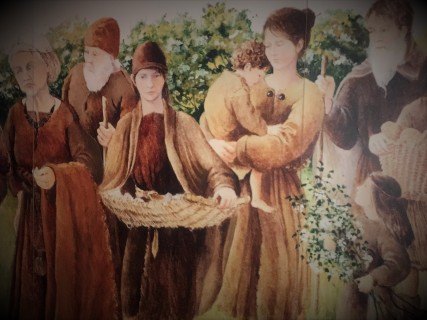
North Ferriby, Melton and South Ferriby across the Humber were thriving areas with over thirty sites found of Bronze Age communities and farms, showing utilisation of the salt marsh with a system of wooden walkways, thought to be used for winter cattle grazing, and clusters of wooden stakes used as traps for fish and birds.
Families (sometimes more than one per house) lived in round houses with walls of wooden posts and wattle-and-daub panels and a conical thatched roof. In the wetlands of Holderness, perhaps some of these houses were on stilts, as found in other wetland regions.
In the middle of the house was a fire used for cooking, heat and light with stone seats arranged around this. Beds were wooden boxes filled with straw and were placed around the circumference of the round house. They would have had clay pots, cups and platters, wooden spoons and wooden buckets with brooms for cleaning.
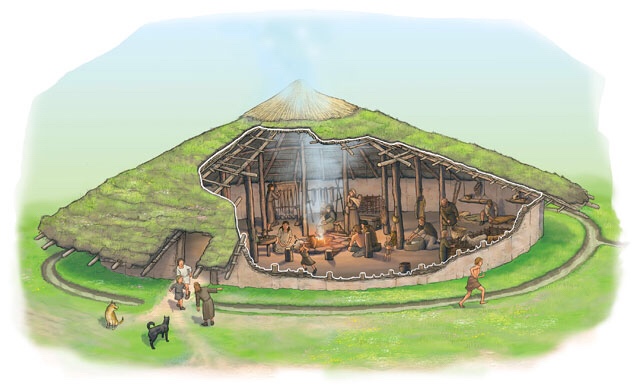
“Textile production was well underway at this time. Women would wear long woollen skirts and short tunics. The men wore knee-length wrap-around skirts, or kilt-like woollens, as well as tunics, cloaks and one-piece garments. They were also clean-shaven, long-haired and wore round woollen hats.”
BBC – History – Ancient History in Depth: Bronze Age Britain
Houses may have had looms for creating fabric for clothing and blankets and areas for basket weaving and metal work. They may have had animal drawn wooden carts to travel distances, although the main mode of transport was via the waterways on boats. Other jobs might include farmers, fishermen, hunters, and guards patrolling for danger. In some communities there might be a shaman or holy man. The rivers Humber and Hull were sacred places to inter offerings to the Gods, as were many rivers and lakes in this era.
The Roos Figures
In Roos, near Beverley, five wooden ‘doll’ figures with quartzite eyes, a box and a small boat for them to fit in was found in 1836 buried deep in clay, suggesting that at the time they were interred there, (around 600BC) this was in or near water. They are now on display at the Hull Museum Quarters.
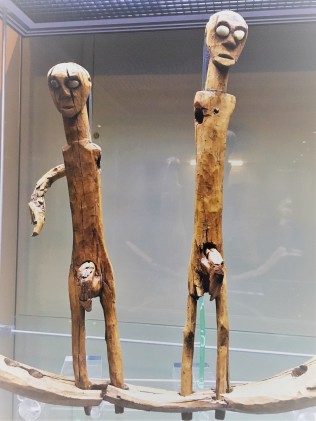
Could they have been an offering to the water God, perhaps to request safe passage across the sea? We may never know, but it’s an interesting thought given the practice of the time.
Bridlington’s Stonehenge?
Early Bronze Age also saw the rise of megaliths, monuments and henges across Britain and in East Yorkshire folk may have made the journey to Rudston near Bridlington, home to a 25ft tall sacred stone monolith, which still stands in Rudston Parish Churchyard. To the north of this was a Class II Henge which was an oval bank with opposing northwest and southeast entrances. Inside this was a levelled central area with evidence of a line of posts in the middle. The whole monument would have been around 312ft in diameter which is roughly the same size as Stonehenge. It is likely that in the beginning this was sacred burial ground and maybe a place of gathering and appeasing the ancient Gods. As with Stonehenge it may have later been also used as a calendar and for solstice celebrations.
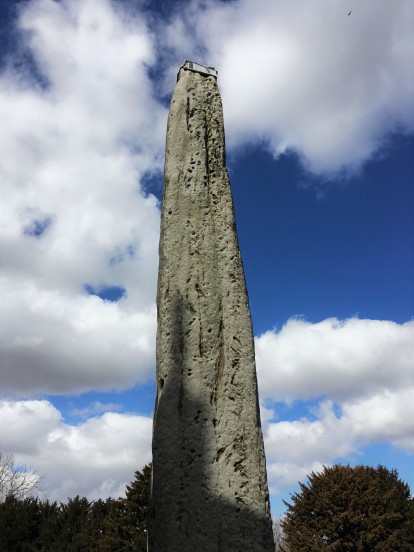
The area is now pasture with no obvious echoes of the past, except for the towering Monolith in Rudston churchyard, which incidentally is the tallest Neolithic standing stone in Britain.
Weighing around 26 tonnes and quarried from a site 10 miles away at Cayton Bay, it was brought to this site around 2000 BC. Bearing in mind this sits on a hill, it is incredible that this was achieved in the first place, and it gives credibility to the fact that this was a very sacred place.
Evidence of belief in the after life is also seen by the artefacts that were often buried with the person, such as personal belongings, food, pots, weapons for protection and jewellery. They were either buried alone, near to family members, cremated and left in clay pots or interred in sacred waters such as rivers, lakes or the sea.
By the late Bronze Age much of East Yorkshire was carved out by a series of embankments and dykes used as boundaries for communities, some of which have been found in the Hull valley and more extensively across Beverley, which were possibly used up to the Roman period.
A gradual influx of settlers over the Bronze Age inevitably brought with it a growing sense of possession and tenure over their lands, homes and farms and with this came motivation to band together into larger communities to defend what was theirs.
